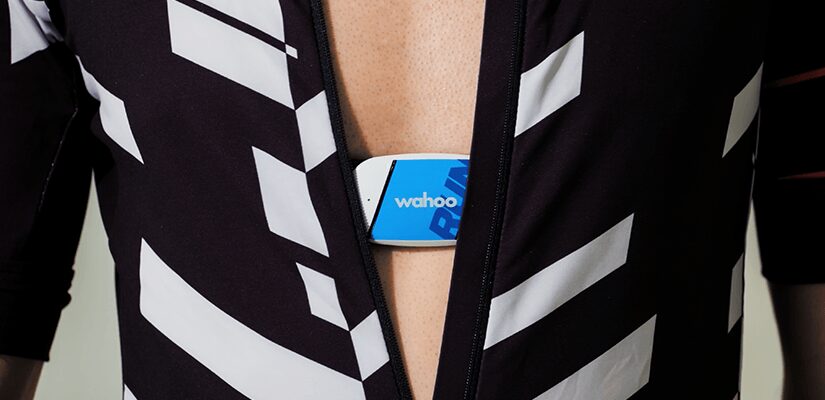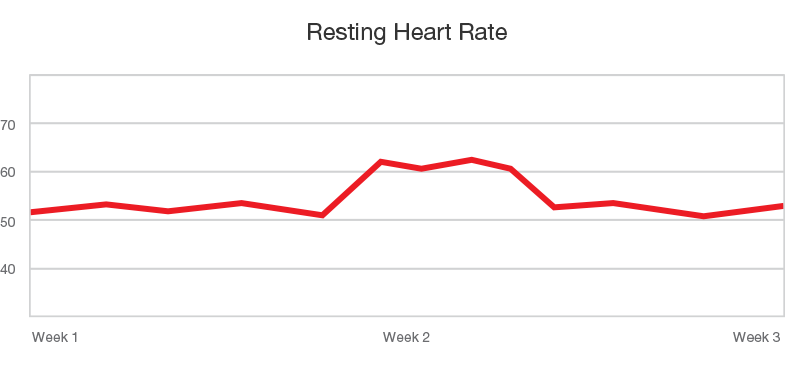How to Measure Recovery with Resting Heart Rate

Cyclists who ignore metrics like Resting Heart Rate (RHR) to measure their recovery are leaving a lot on the table. This simple approach to quantifying recovery takes little time or effort, it can guide your decision making, and it might even give you that little bit more you need to win.
Overview
Power meters enable riders to precisely measure their training while on the bike, but what about when you are off the bike and recovering? Unfortunately, quantifying recovery isn’t as precise of a science with current, widely-available technology. Consequently, one of the best tools we have is our own heart rate.
When using heart rate to measure your recovery, you still have to take into consideration the variable nature of heart rate. Sleep, nutrition, hydration, environment, stress and a host of other variables can have a substantial effect on your heart rate. As a result, the process of using resting heart rate to measure recovery is mostly focused on eliminating these variables.
What is Resting Heart Rate (RHR)?
In an ideal world, your heart rate at complete rest should represent the minimal cardiac function required to keep you and your body conscious. In most cases, a low resting heart rate is the result of above average fitness. However, this is relative to each individual. Conversely, an abnormally elevated resting heart rate can be an indication of many things. For this purpose of this article, an elevated resting heart rate is being used an indication of needed recovery.
Why Measure Your RHR?
Whereas your FTP is a good indicator of your work, resting heart rate can be a very good indicator of recovery. The proper combination of work and recovery is necessary for continued improvement in your performance. The goal is to fit in as much work as possible without accumulating excessive fatigue.
If you haven’t put in enough work, you’re simply not going to be fast enough. But, if you haven’t recovered enough, you could be headed for a whole host of problems. A lack of proper recovery leads to fatigue, which holds you back from the benefits of your training. Worst of all, excessive fatigue often leaves you prone to illnesses that can derail your training.
By having an accurate fix on your RHR, you can learn how your body is responding to your training and be able to recognize the onset of illness before seeing symptoms.
How Do You Measure Your RHR?
Before getting into the mechanics of measuring your RHR, it is important to remove as many variables as possible. You should always measure your RHR at the same time every day, and the best time to do so is first thing in the morning before you get out of bed. This ensures that your body is rested and that you have had little to no chance to alter your physical or mental state — or your heart rate.
Having said this, it is extremely important to take into consideration the previous day’s nutrition, hydration and physical and mental activities. A particularly taxing day, dehydration or abnormal nutrition may manifest itself the next morning as an increased resting heart rate. On the other end of the spectrum, your resting heart rate may be lower after a day of rest or proper hydration and nutrition. A key to effectively using RHR to measure your recovery is to always consider these variables.
Heart Rate Measuring Tools
There are a number of ways you can measure your resting heart rate. You can either do it the old-school way with no devices, or you can use modern technology to make the process even easier.
Fingers and Counting
The most accessible form of heart rate measurement is 100% free. Simply place your middle and index finger on your the underside of your wrist, or where your jawline meets your neck. Count the beats for 20 seconds, then multiply that number by three. While this is a relatively simple process, it’s not perfect. This method is rife with opportunity for human error since it relies on your sense to feel each beat and keep count. This may sound easy, but depending on the condition you find yourself in when measuring your RHR, it can be easy to make a mistake.
Chest Strap Heart-Rate Monitor
Many athletes own a chest strap heart-rate monitor, so they have an accessible and easy to use way of removing the human error from RHR measurement. However, while chest strap heart-rate monitors are an improvement from using your hand, they come with their own set of problems. Chest strap heart-rate monitors aren’t comfortable, and trying to get quality sleep with one can be tough. Additionally, not many chest straps have specific apps that measure your resting heart rate while you sleep. These problems cause most people to just put their chest strap on once they wake, negating much of the potential benefit of a chest strap.
Wrist Strap Heart-Rate Monitors
A large number of bracelet-style optical heart-rate monitors are now being released, and they make measuring your resting heart rate an automated task. The one that I use is a Fitbit Charge HR, and it is much more comfortable than a chest strap. I’ve found it’s optical heart-rate sensor to be slightly slow to adjust, but it is accurate when compared to a chest strap heart rate monitor. It pairs with the FitBit app on my iPhone, automatically identifies my RHR and graphs my RHR from day to day.
What does my RHR mean?
As in every case when using heart rate, your RHR is relative to you — and you only. Comparing RHR values from person to person is tempting, but it leads to misinformation more often than not.

The goal should be to recognize changes in your RHR values, understand what those fluctuations mean and make decisions using this data. You may be surprised at first to see regular fluctuations in RHR, but remember that heart rate is highly variable. Give yourself at least a month before making any type of decision based on fluctuations in your RHR. After a month of gathering data, you should be able to anticipate these changes and weed out any “false positives”.
Once you have a general idea of how your RHR trends over time, you are ready to make informed adjustments to your training. Here’s what to look for:
Increase of less than 10% in RHR
The first thing to do when seeing an increase in RHR is to examine the past couple of days’ activities. Are you dehydrated or have you made a major change in your diet? Did you have an especially difficult day of training yesterday? Chances are one of these changes is to blame for a minor change in RHR. Minor fluctuations in RHR like this are to be expected and in most cases are nothing to worry about.
Increase of more than 10% in RHR
If you see an increase in RHR around 10% or above, chances are you are in a vulnerable state and you may already be sick. When your body is combatting a sickness in addition to maintaining a conscious state, it’s having to work overtime. This is shown in a significant increase in RHR. More often than not, this increase in heart rate will precede any symptom of sickness. This is a great opportunity to get the upper hand on the sickness by resting. As your body recovers, you’ll see your RHR slowly return to a reasonable rate.
Decrease in RHR
You should see your RHR decrease gradually over long period of time with regular training. A lower RHR is a general indicator of increased fitness, so if this is the case, go ahead and pat yourself on the back!
Small or inconsistent decreases in RHR generally indicate that your rest levels, hydration levels and nutrition are all doing well. If this is the case, you are ready for more training — so get to it and have fun!
Listen to Certified Cycling Coaches Discuss Measure Your Heart Rate
“How to Measure Recovery with Resting Heart Rate” is one topic we covered in last week’s episode of the Ask a Cycling Coach podcast. Listen to the episode’s full recording below to hear this and other questions from cyclists get answered by our certified cycling coaches.
Additional Notes
TrainerRoad’s Ask a Cycling Coach podcast is dedicated to making you a faster cyclist. It gives you the chance to get answers to your cycling and triathlon training questions from USAC certified coaches Chad Timmerman, Jonathan Lee and special guests. Learn more about other topics we covered in the latest episode with our resources below:
- How to set up your bike on the trainer
- How to measure your recovery
- How to switch training plans
- How to improve pedal stroke efficiency
- How to become a faster sprinter
- Does base training hurt your FTP?
- How does gearing affect an electronic trainer?
- How to train for the Dirty Kanza
- How sprinters can train for climbing
- Should you train your weaknesses or strengths?
- How to train for steep climbs
- How to adjust training for missed workouts
- Is tempo training beneficial for triathletes?
- Why is my indoor power higher than my outdoor power?
- How to do form sprints
- How to measure an FTP test
- How to base train for triathlon
- Should I workout indoors with a fan?
If you have a question that you’d like to ask Coach Chad, submit your question here. We’ll do our best to answer them on the next episode of the Ask a Cycling Coach podcast.